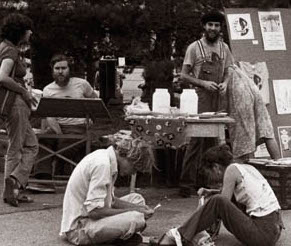Nice Review of Consensus for Cities
Thanks to Pablito of Reclaiming Quarterly for this positive review of C.T. Lawrence Butler’s Consensus for Cities! This is a pre-Occupy Wall Street review, of the proof edition C.T. circulated. He had planned to further edit it before the final print. But when we got involved with Occupy, we sold out of/gave away the five hundred proof editions and printed another run of five hundred. I just noticed this write up today. —Wren Tuatha
Consensus for Cities
A forthcoming book by C.T. Butler
Reclaiming-tradition groups often make decisions by consensus, and may be familiar with C.T. Butler’s pamphlet: On Conflict and Consensus.
His upcoming Consensus for Cities both deepens and broadens participatory decision making — to cities, community groups, and families.
Don’t let the title mislead you — consensus for cities is only one of several valuable ideas and discussions therein.
Cities lays out a detailed structure for consensus decision making for up to 100,000 people. If you want to know how many hours per week you’d spend and in what type of meetings, it provides a thorough and surprisingly tolerable estimate. The book also descibes a parallel mediation structure for disputes which are not easily resolved through the decision-making structure.
Cities’ discussion of and design for healthy volunteer-oriented community groups feels immediately relevant, useful, and democratically respectful. Other nonprofit management literature often focuses on hierarchical management and boards to the detriment of volunteer power, intelligence, and energy. If you have or are starting a community group, this book is worth reading.
Is the “family of the future” structured like an affinity group? Why might adopting consensus actually increase conflict? What is the psychology behind each formal consensus step?
Butler deepens his earlier consensus work by addressing these and other questions. Charts, definitions, and facilitation techniques are clear and useful for consensus practitioners.
Consensus for Cities is soon to be available from Food Not Bombs publishing, where you can also find a downloadable version of On Conflict and Consensus. Visit www.consensus.net.
— Reviewed by Pablito / Reclaiming Quarterly Issue #100, p. 7
Notes from Wren: The website, www.consensus.net, is offline for renovations. Watch for its return in 2016! Also, you might be wondering how to acquire Consensus for Cities. Just contact C.T. Butler at ctbutler@together.net or 301-586-2560. Just found this interesting assessment on a youtube discussion thread:
“This problem is why consensus is being increasingly adopted. It holds all the stakeholders accountable to the group and provides a level structure for negotiating right and need to access. C.T. Lawrence Butler’s “Consensus for Cities” provides good models for scaling the process up, so that accountability and responsibility are not restricted to the immediate group. This way, an isolated group can be held accountable to worldwide stakeholders, i.e. no one could overconsume at others’ expense.”
—enkiduslover
Subscribe to this blog's RSS feed
Food Not Bombs and Polyamory
I’ve been working with my partner, Food Not Bombs cofounder and consensus author C.T. Butler, on writing about his life. We’ve been mapping the overlaps of activism and personal life. Of course for C.T., the personal is always political and the political is immediate and personal. He tells stories of the first Food Not Bombs collective, a group of activists who had met while occupying the construction of Seabrook Nuclear Power Station.
Forged in the crucible of early punk, the collective was youthfully recreating the sex, drugs and rock & roll meme on their own terms. They practiced polyamory, although that word had not been coined yet. And they brought a feminist form of consensus to their collective. In her 2010 book, Polyamory in the 21st Century: Love and Intimacy with Multiple Partners, Deborah Anapol records some of C.T.’s stories, intersecting sex and politics:
C. T. Butler, who is now in his fifties, has lived polyamorously and been actively engaged in working for social change for his entire adult life. In 1981, he cofounded the Food Not Bombs collective, which is still going strong around the world as a grassroots organization to provide free vegetarian meals for the hungry and raise awareness about homelessness as well as protesting war and military spending.

C.T. reports that for two years in the early days of Food Not Bombs, the collective was run by three men and three women who shared a large house and whose relationships included sexual involvement with each other in one way or another. They went so far in challenging the status quo that they had the experiment of not having their own personal bedrooms in the house. C.T. recalls, “Downstairs, we had the kitchen, dining room, living room, and study; upstairs, we had the sleeping room, the sex room, the library/meditation room, and the music room. We all slept together in one big bed in the sleeping room, and sometimes, some would sleep in the sex room or music room. There were others moving in or moving out of the collective all the time.”While many of the young people who formed the Food Not Bombs collective were already lovers, they were “seasoned activists” who viewed their sexually radical lifestyle as a precaution against infiltration. C.T. re- calls that “we were quite concerned about infiltration at the time and felt that the willingness to be sexual and deeply intimate with everyone else in the collective was a way to prevent infiltration. Obviously, we did not think it was absolutely foolproof; we just thought it was helpful. However, that does not mean we required everyone to have sex with everyone else in the collective; it was that we were interested in experimenting with sexual relations in an outside-the-box way, and we saw the usefulness of this ex- perimenting in strengthening our bonds and our effectiveness as political activists. Therefore, in practice, if someone was unwilling to experiment, they were not suitable collective members. If they were comfortable with open relationships and had a willingness to experiment sexually, as dem- onstrated by their behavior, then we assumed they were very unlikely to be an agent of the state.”
In keeping with their anarchist politics, the collective were strong adherents of consensus decision making. Any member could call a meeting called a group-group, where everyone would engage in a discussion that could not end until everyone agreed on a resolution, which might mean two or three days with breaks only for eating and sleeping. C.T. reports that these group-groups were called only maybe five times in two years to address things like “dealing with a sexual predator, kicking a member out, and sexism.”
C.T. says that jealousy was never much of a problem for him because of his “political analysis of life.” He explains that, “from early adulthood, I realized that possessive behaviors and the idea that one person could control the behavior of another because of the concept of marriage was really just another form of slavery, one person owning another. I have never wanted to control or have another person all for myself. With regard to the jealousy my partners would feel, I was very patient and clear that jealousy is primarily based on fear. I would take the time to help my partner uncover her fear and manage it so that it would either go away or, at least, not destroy our relationship. Generally, that worked pretty well.” During the 1980s and 1990s, he helped start polyamory discussion groups throughout New England, lived in a series of polyamorous families, and fathered several children. For C.T., polyamory was as much a tool for political activism as a means of personal gratification.
One factual correction: Although C.T. “parented” several children, as in helping to raise them, he only fathered one child.
Interestingly, we discovered that C.T. is listed among famous poly people in the German Wikipedia article on polyamory. He pops up on lists here and there, often on lists of notable vegans or vegetarians.
As I post this, we are helping Cricket, our puppy, negotiate her play relationship with Leeloo, our cat. Cricket stands over her, trying to swallow the cat in slow motion, head first. Leeloo objects by biting and clawing Cricket’s leg.
“You have to check in with your partner, Cricket. Leeloo’s not having fun. Learn the signals,” I say.
“Yeah, you can’t just chew on ‘em,” C.T. concludes.
Great relationship advice from a poly activist…Decades of experience that you can take to bed…Meanwhile, Leeloo needs a safe word.



